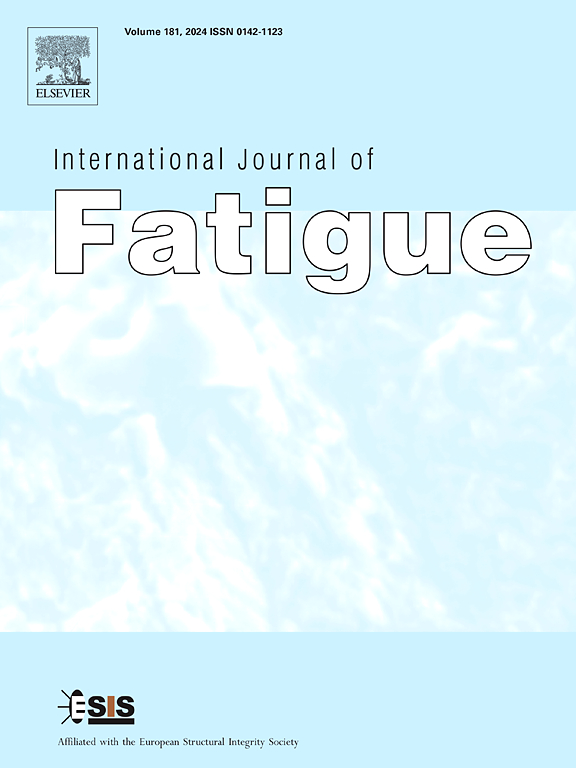Reliability analysis method for aircraft structure corrosion fatigue based on Chaboche model
IF 5.7
2区 材料科学
Q1 ENGINEERING, MECHANICAL
引用次数: 0
Abstract
A reliability analysis method for predicting the service life of aircraft structures considering corrosion damage has been proposed. This method introduces corrosion damage as the initial damage into the Chaboche fatigue cumulative damage model, and uses Monte Carlo method to simulate and reconstruct the corrosion fatigue damage process of the structure, achieving reliability analysis of the corrosion fatigue life of aircraft structures. To verify the effectiveness of the proposed method, SO2 salt spray accelerated corrosion test and corrosion fatigue test were conducted on A100 steel as a case study, revealing the damage law and mechanism of A100 steel under corrosive environment and fatigue load. By establishing a Chaboche fatigue cumulative damage model for A100 steel and completing model parameter calibration, the reliability of structural corrosion fatigue life was evaluated using the proposed reliability method. This method can improve the maintainability and reliability requirements of aircraft structures in corrosive environments, providing a new approach for aircraft structure safety assessment, life monitoring, and life extension.
基于Chaboche模型的飞机结构腐蚀疲劳可靠性分析方法
提出了一种考虑腐蚀损伤的飞机结构寿命可靠性预测方法。该方法将腐蚀损伤作为初始损伤引入到Chaboche疲劳累积损伤模型中,利用蒙特卡罗方法对结构的腐蚀疲劳损伤过程进行模拟和重构,实现对飞机结构腐蚀疲劳寿命的可靠性分析。为验证所提方法的有效性,以A100钢为例进行了SO2盐雾加速腐蚀试验和腐蚀疲劳试验,揭示了A100钢在腐蚀环境和疲劳载荷作用下的损伤规律和机理。通过建立A100钢的Chaboche疲劳累积损伤模型并完成模型参数标定,采用提出的可靠性方法对结构腐蚀疲劳寿命进行可靠性评估。该方法可提高飞机结构在腐蚀环境下的可维护性和可靠性要求,为飞机结构安全评估、寿命监测和寿命延长提供了新的途径。
本文章由计算机程序翻译,如有差异,请以英文原文为准。
求助全文
约1分钟内获得全文
求助全文
来源期刊

International Journal of Fatigue
工程技术-材料科学:综合
CiteScore
10.70
自引率
21.70%
发文量
619
审稿时长
58 days
期刊介绍:
Typical subjects discussed in International Journal of Fatigue address:
Novel fatigue testing and characterization methods (new kinds of fatigue tests, critical evaluation of existing methods, in situ measurement of fatigue degradation, non-contact field measurements)
Multiaxial fatigue and complex loading effects of materials and structures, exploring state-of-the-art concepts in degradation under cyclic loading
Fatigue in the very high cycle regime, including failure mode transitions from surface to subsurface, effects of surface treatment, processing, and loading conditions
Modeling (including degradation processes and related driving forces, multiscale/multi-resolution methods, computational hierarchical and concurrent methods for coupled component and material responses, novel methods for notch root analysis, fracture mechanics, damage mechanics, crack growth kinetics, life prediction and durability, and prediction of stochastic fatigue behavior reflecting microstructure and service conditions)
Models for early stages of fatigue crack formation and growth that explicitly consider microstructure and relevant materials science aspects
Understanding the influence or manufacturing and processing route on fatigue degradation, and embedding this understanding in more predictive schemes for mitigation and design against fatigue
Prognosis and damage state awareness (including sensors, monitoring, methodology, interactive control, accelerated methods, data interpretation)
Applications of technologies associated with fatigue and their implications for structural integrity and reliability. This includes issues related to design, operation and maintenance, i.e., life cycle engineering
Smart materials and structures that can sense and mitigate fatigue degradation
Fatigue of devices and structures at small scales, including effects of process route and surfaces/interfaces.
 求助内容:
求助内容: 应助结果提醒方式:
应助结果提醒方式:


